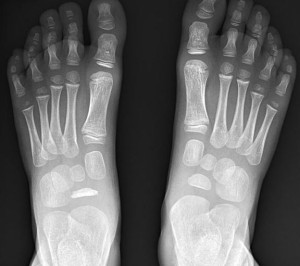Looking around the forums, the fracture of the LisFranc joint is an interesting problem. Lots of people are posting messages in forums asking for help and advice for their fracture. I not sure that this is necessarily a good thing to get medical advice online in forums, but the numbers of people asking for advice was what I found surprising. The LisFranc joint is the joint between the tarsus and metatarsus bones across the midfoot. It is named after the French surgeon, Jacques Lisfranc de St. Martin, who first described the injury during the War of the Sixth Coalition. The injury usually happen when a large weight, such has the foot being driven over by a car, occur. As a results there is often multiple fractures and dislocations that occur. This also means that most cases are not the same and the management of them is complex, hence so many people asking for advice online.
Depends. Everyone has a one leg that is longer than another, but often the difference is so small its not necessarily detectable. Obviously, if a large amount, there is probably going to be problems due to the changes in alignment of the spine and other parts of the body. Obviously if the difference is a miniscule amount, its probably not going to be a problem. Where the debate and discussion is just where is the cut-off point is as to if the difference is clinically significant or not. Some people think a few millimeters is important; yet others think that its not important until it at least a few inches. It is also going to depend on activity levels. A few millimeters might be important if you run marathons. A few inches is not going to be important is you lead a sedentary lifestyle. There is very little research to guide this process. More information is certainly needed to base decisions on.
This is somewhat of a controversial topic as it new, expensive and a lot of unsubstantiated claims get made for it. Fungal infections of the toenails (or onychomycosis) is a common problem. It causes the nails to become deformed and grow with a yellowish discoloration. The biggest issue in this problem is that treatment can takes months as you need to wait until the fungal elements grow out with the nail as it grows. During that time, especially in the damp and moist environment of the shoe, the nail can easily get infected again as the fungus just love that dark and moist environment in the shoe. So, whichever treatment is used, no matter how good it is can easily fail due to the reinfection. The use of the laser has become popular in recent years with lots of anecdotes but no hard science to support it. The FDA have approved it as safe, but have not tested how effective it is. There are plenty of other treatments that have been shown to work. More research is needed to know how the laser treatment stacks up to the other treatments.
Kohlers Disease is a problem with the navicular bone in the arch of the foot in young kids with a peak incidence around are 5 years. It usually presents as a ache on the top of the arch of the foot and often also causes the child to limp. Kohlers Disease is due to a temporary block in the vascular supply to the bone to cause an osteochondrosis or softening of the bone. The exact cause of this is not known, but is often thought to be biomechanical as the bone is an important part of the arch of the foot. On x-ray the bone appears more sclerotic and thinner than the other side:

The treatment of this condition is the use of a cast or splint with a period of non-weight bearing to allow the bone to heal.
